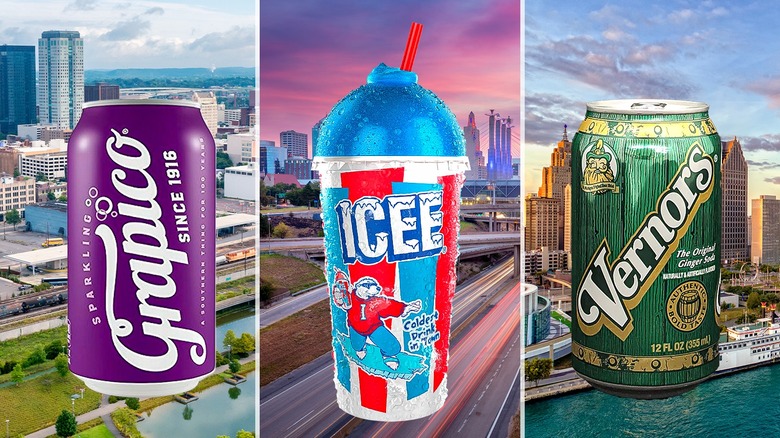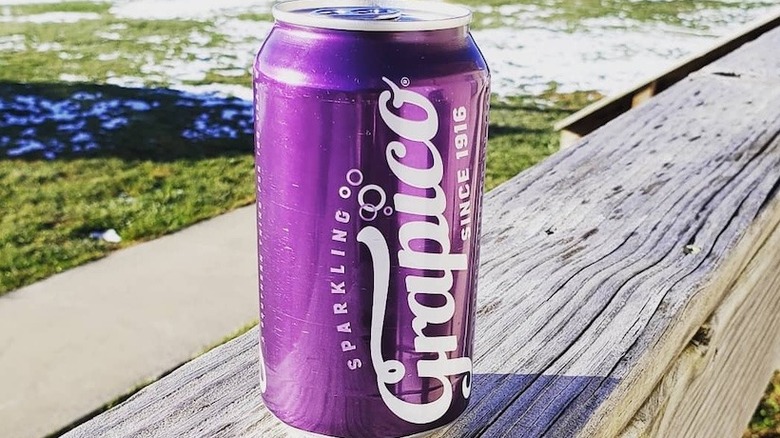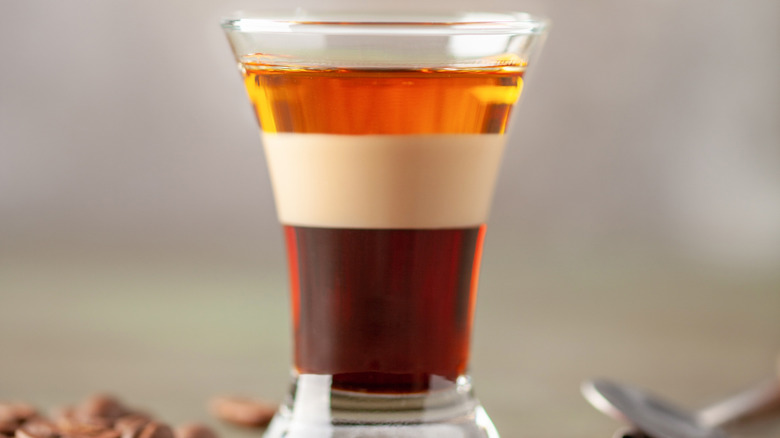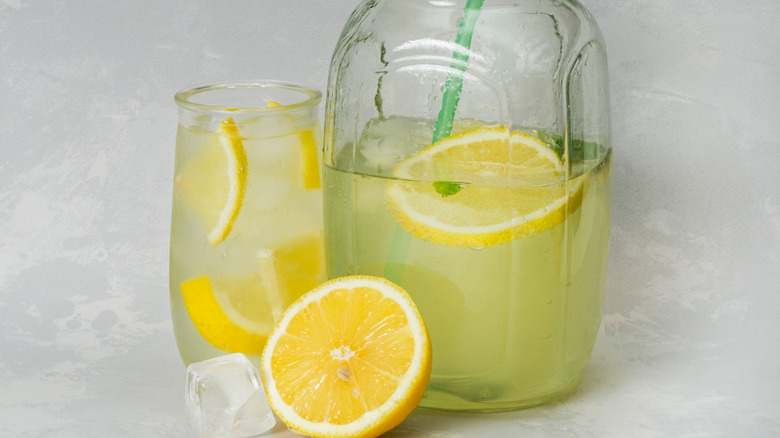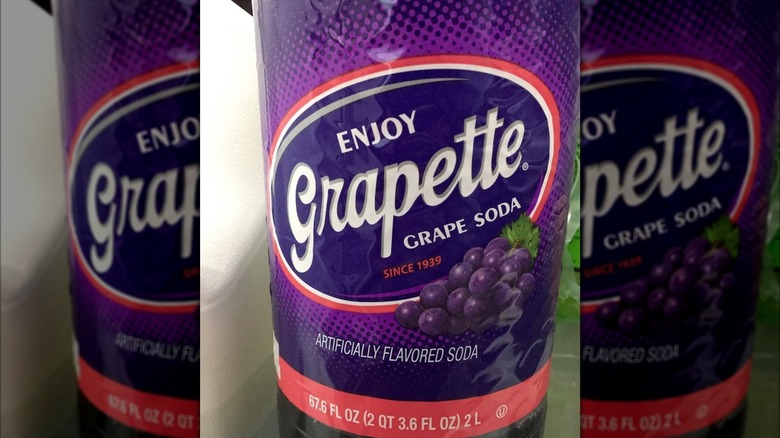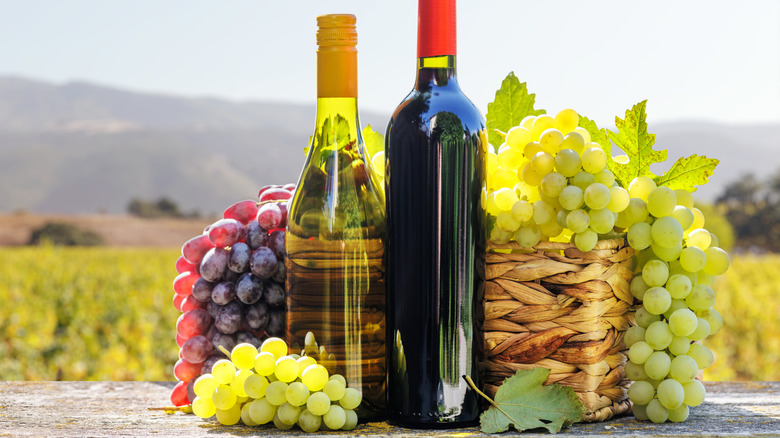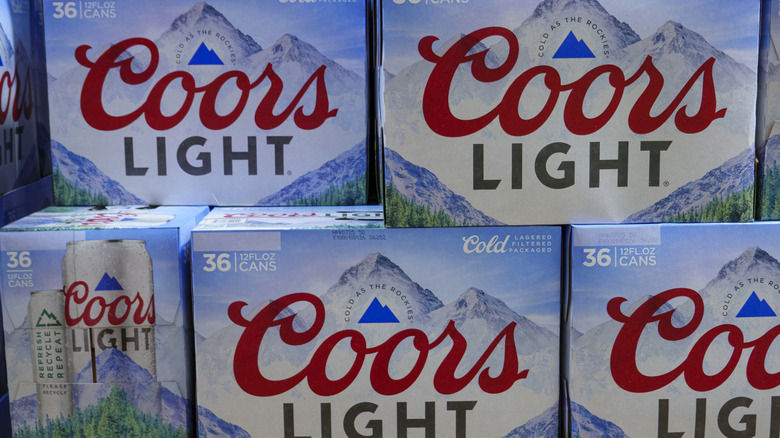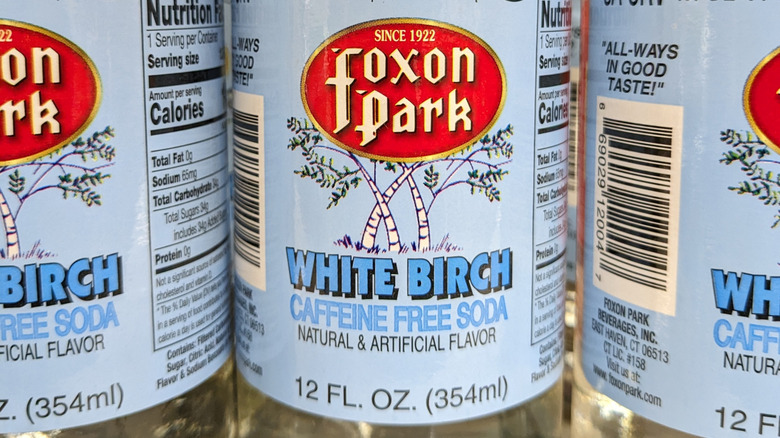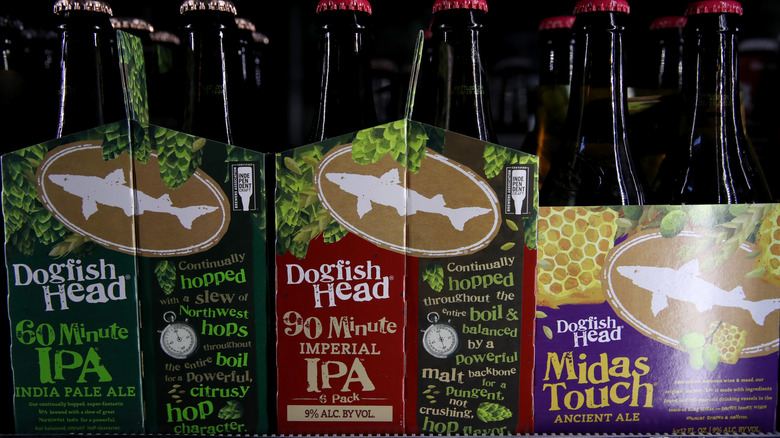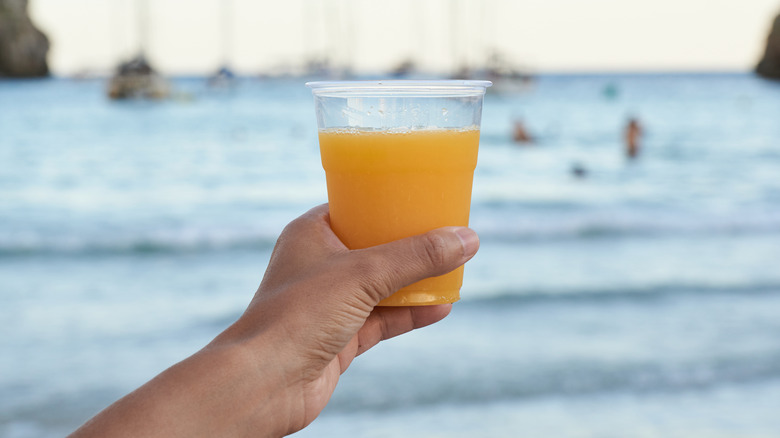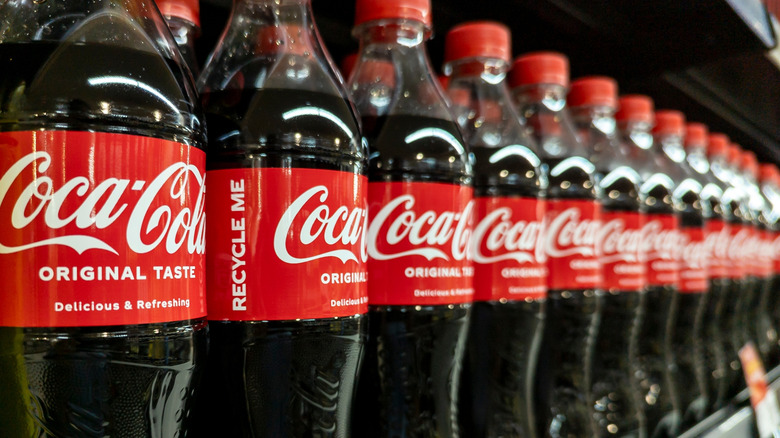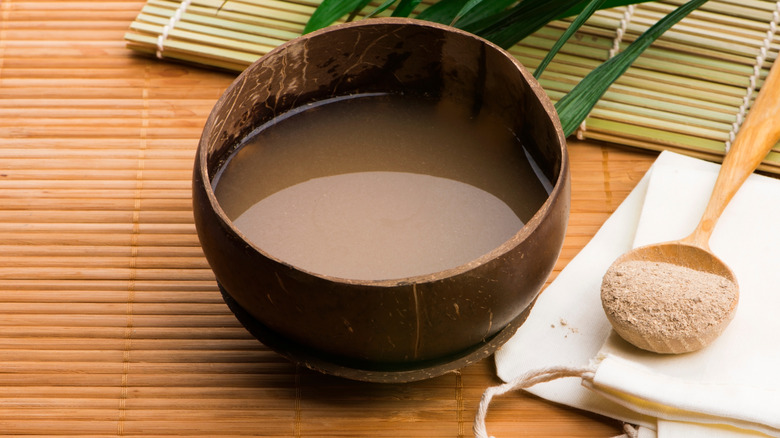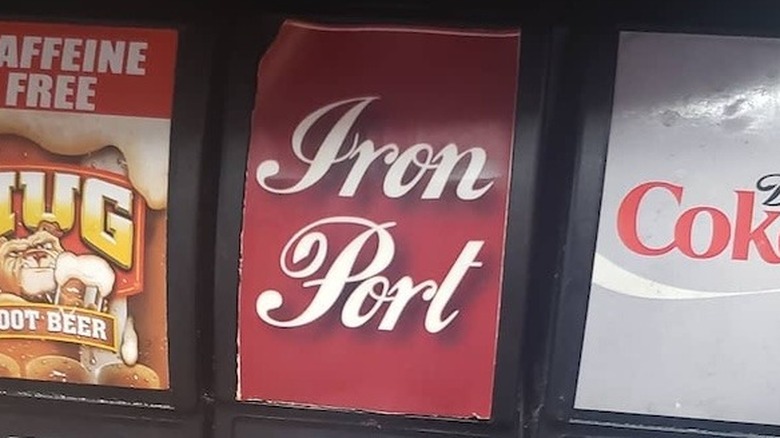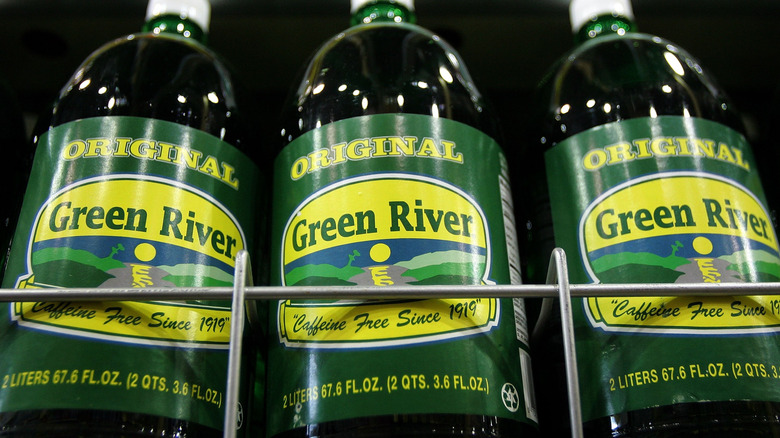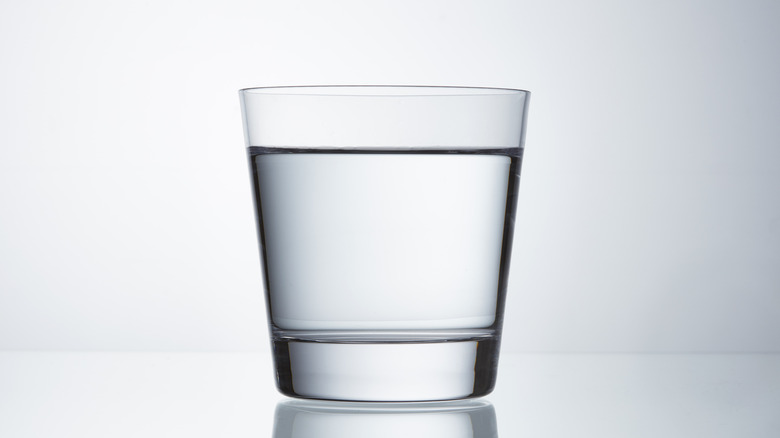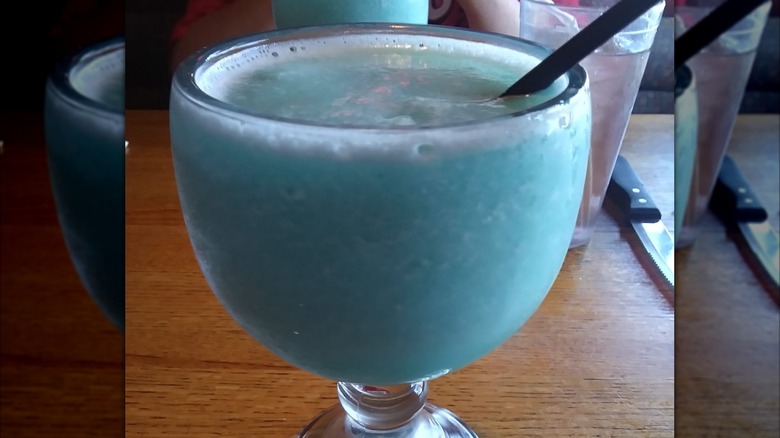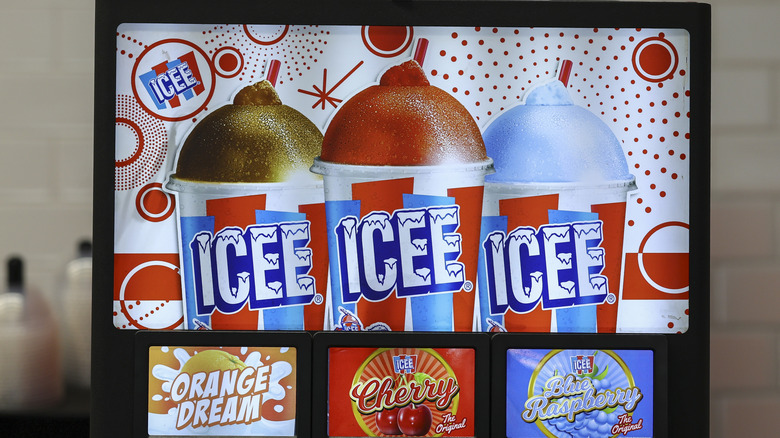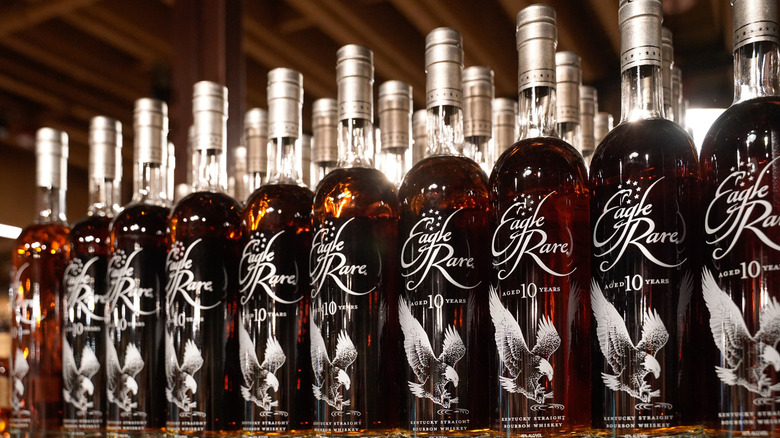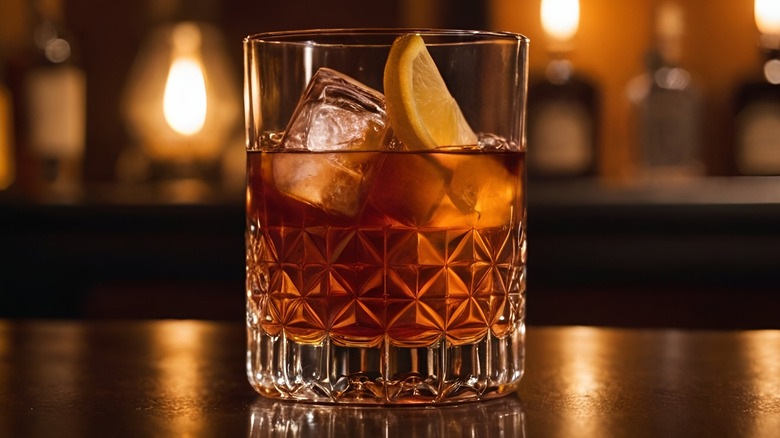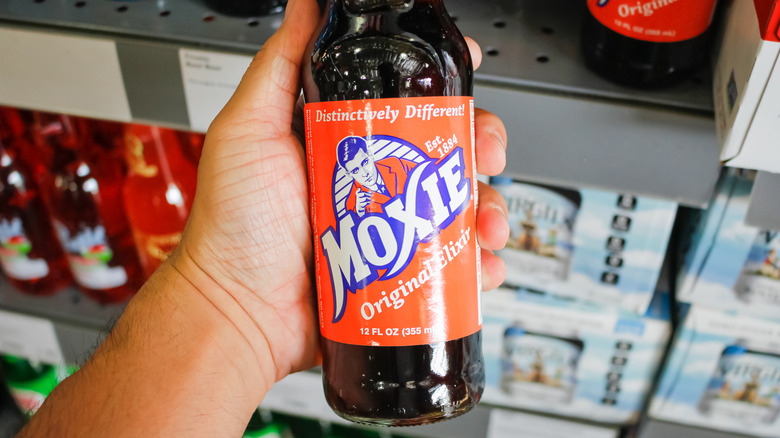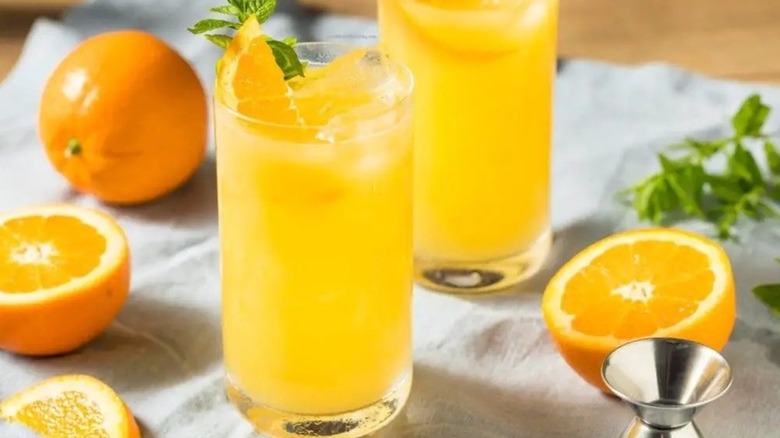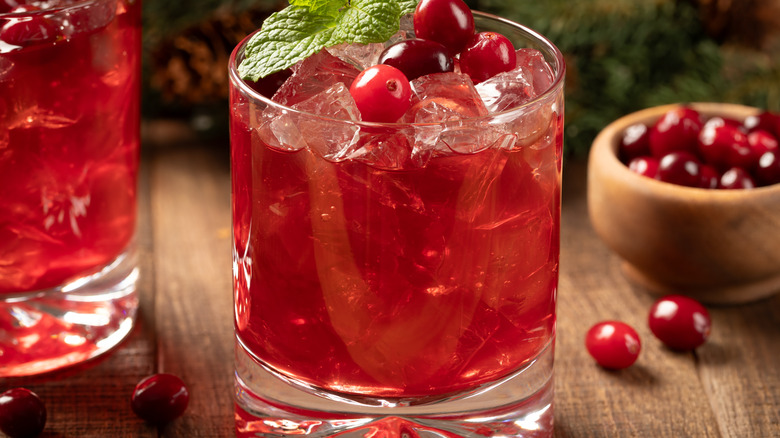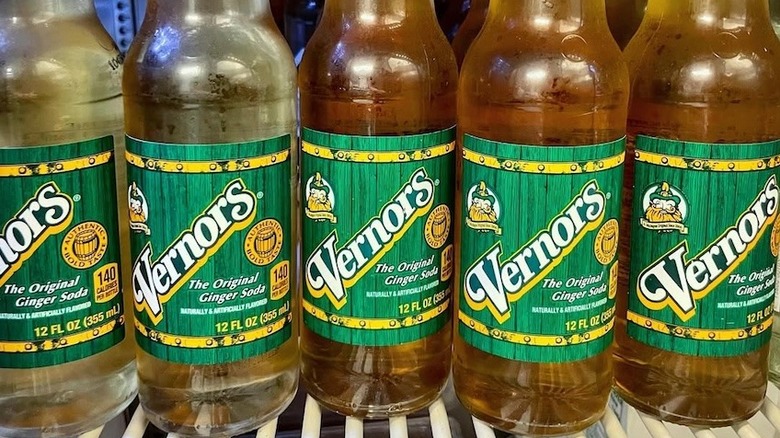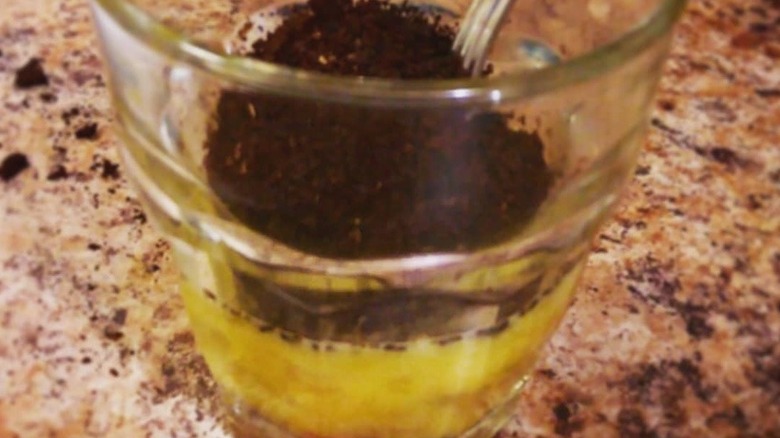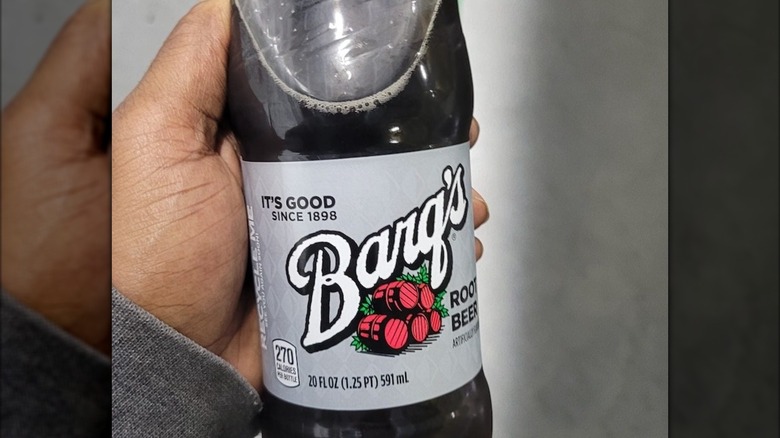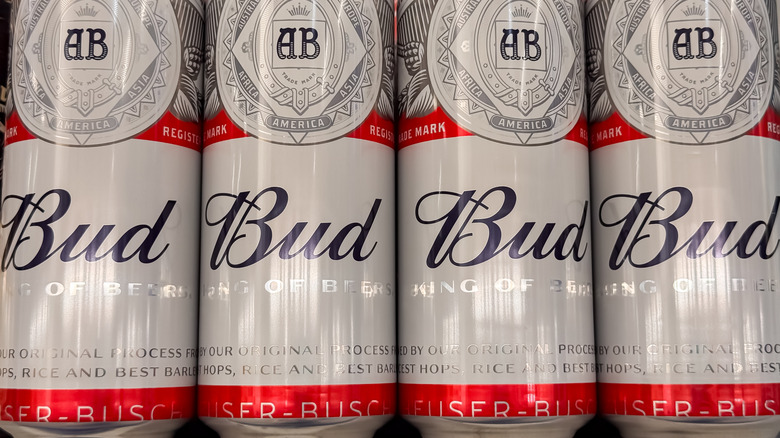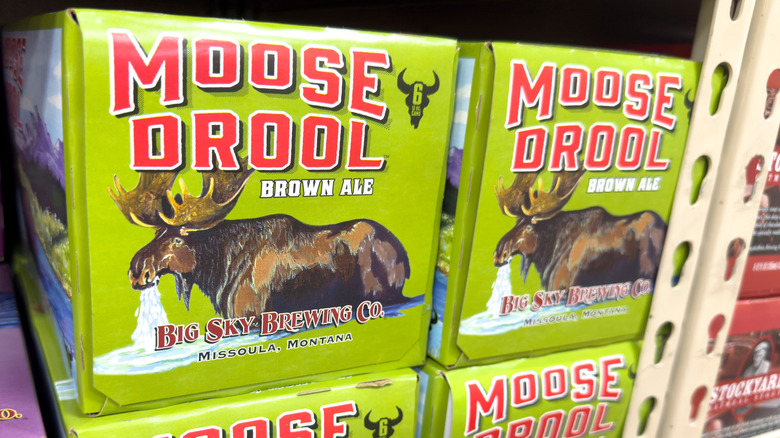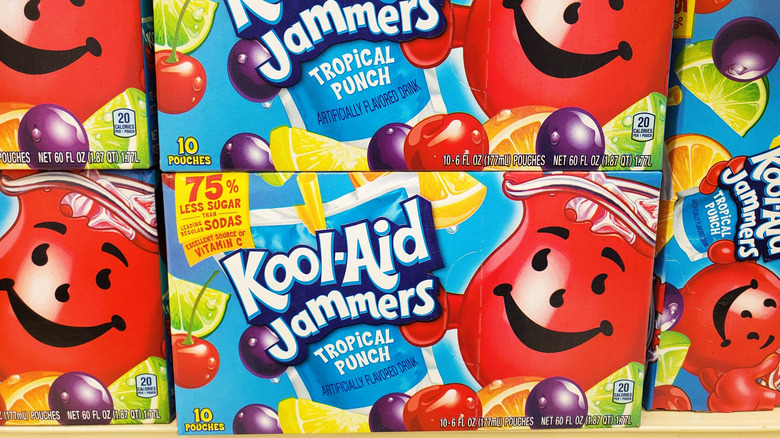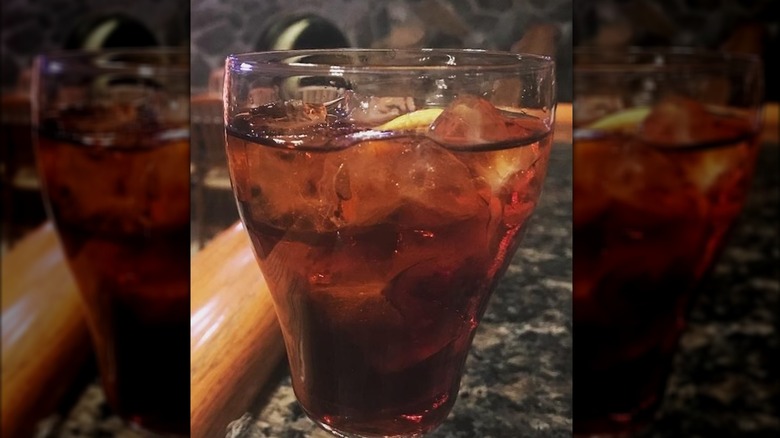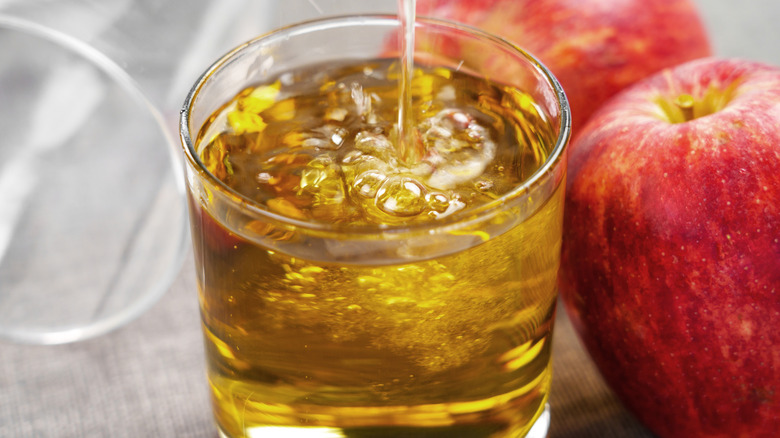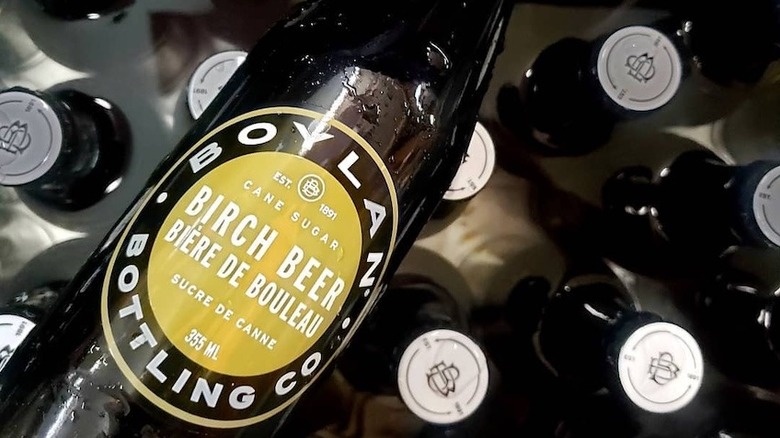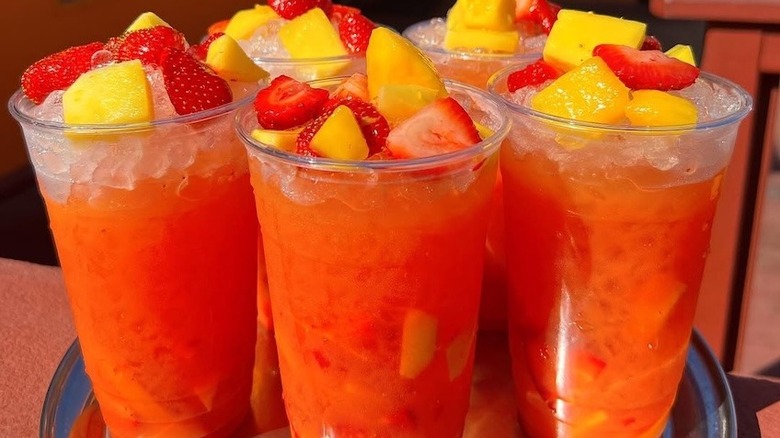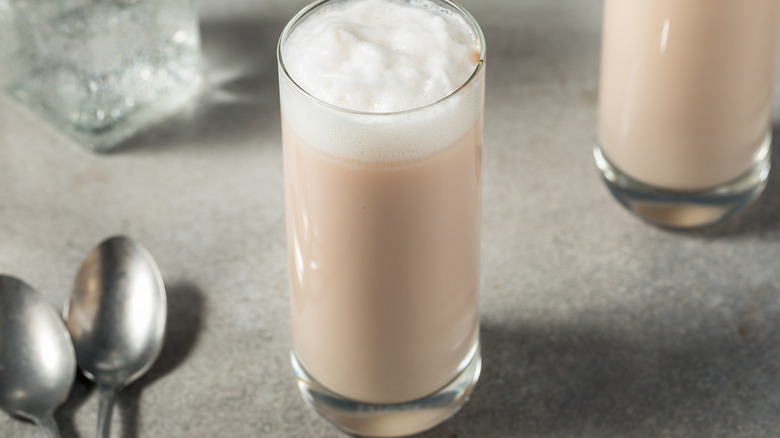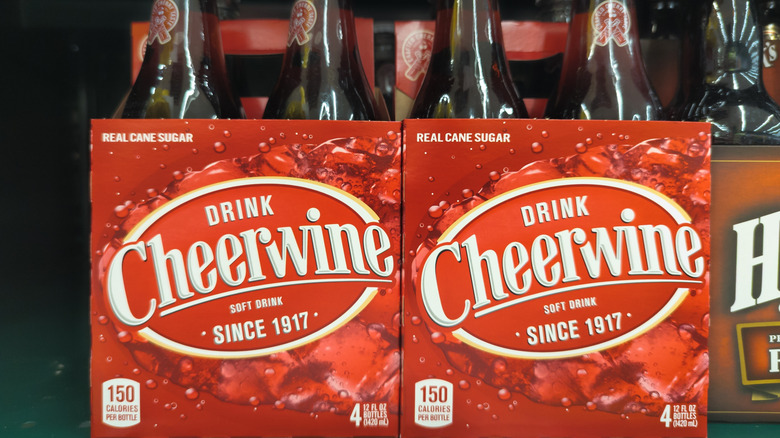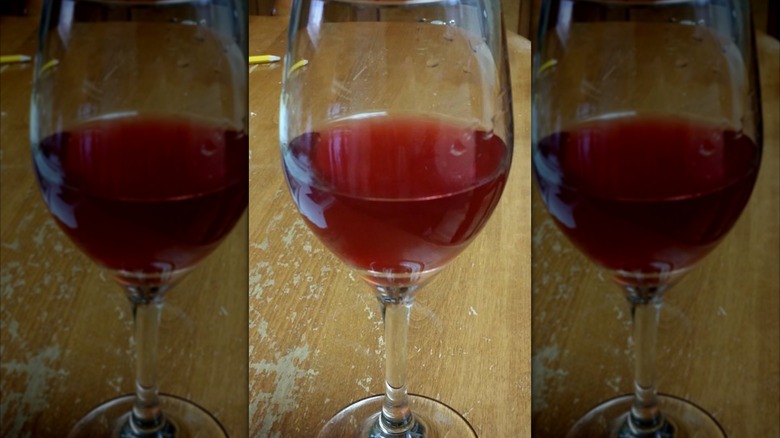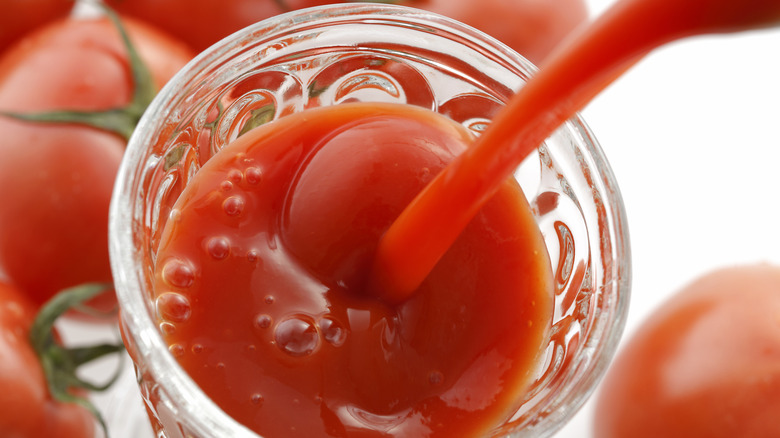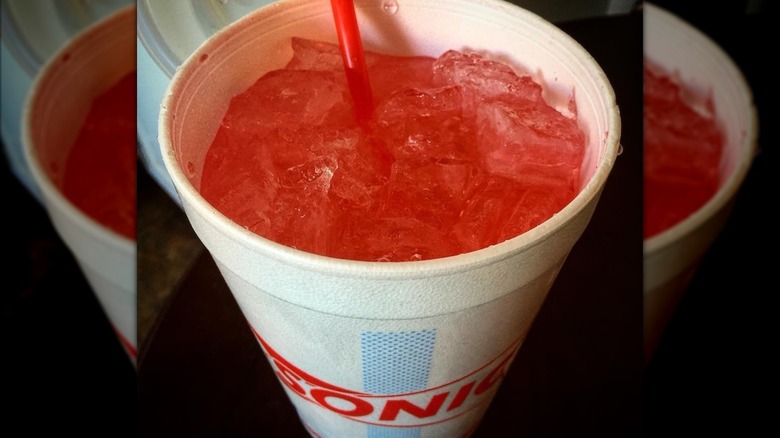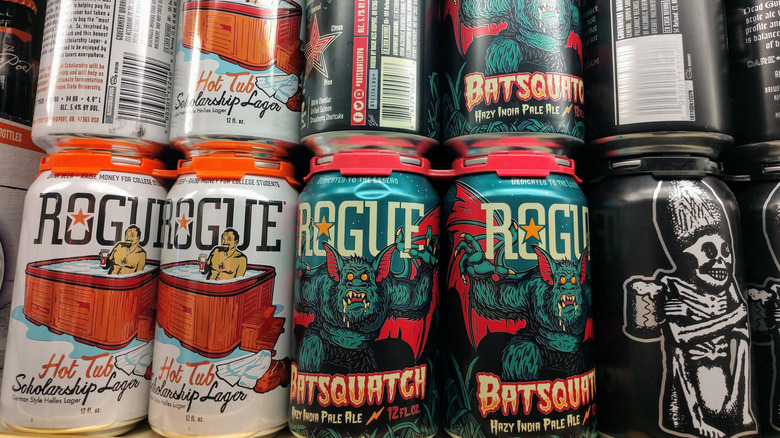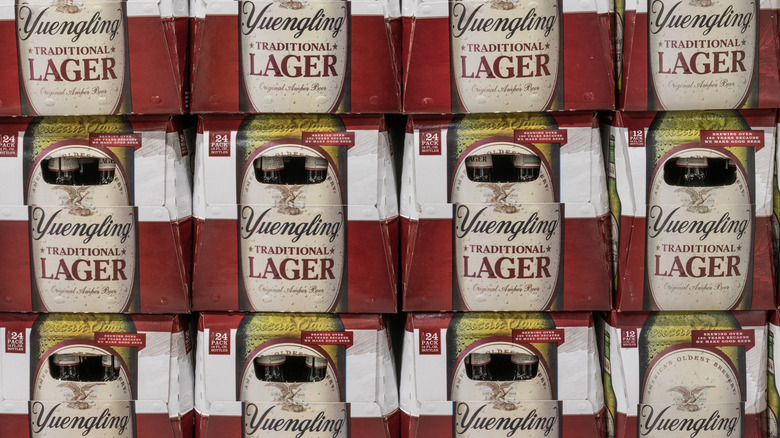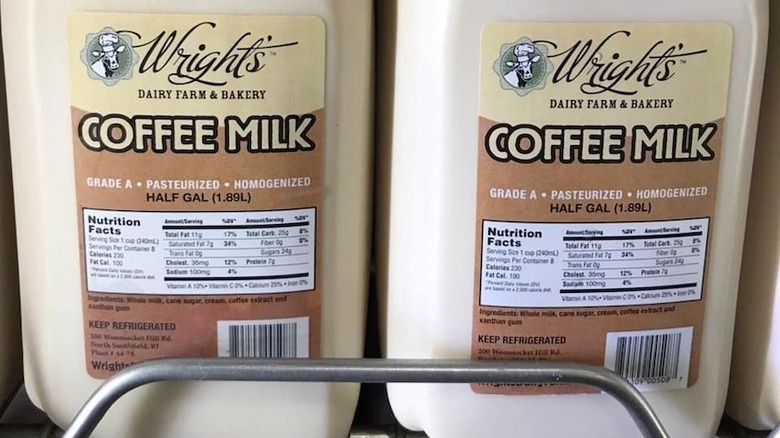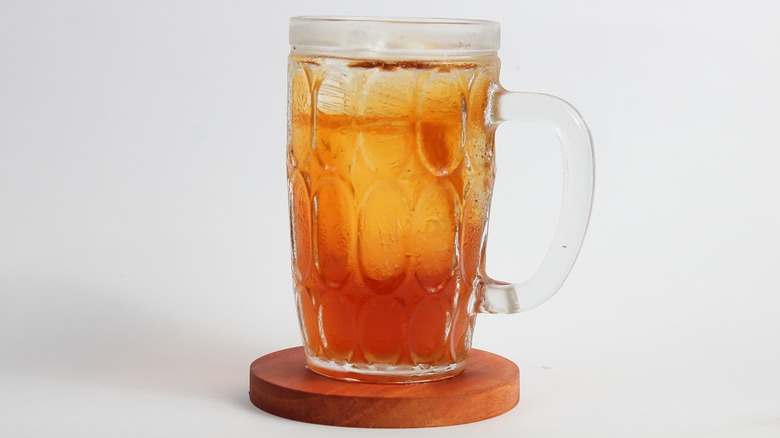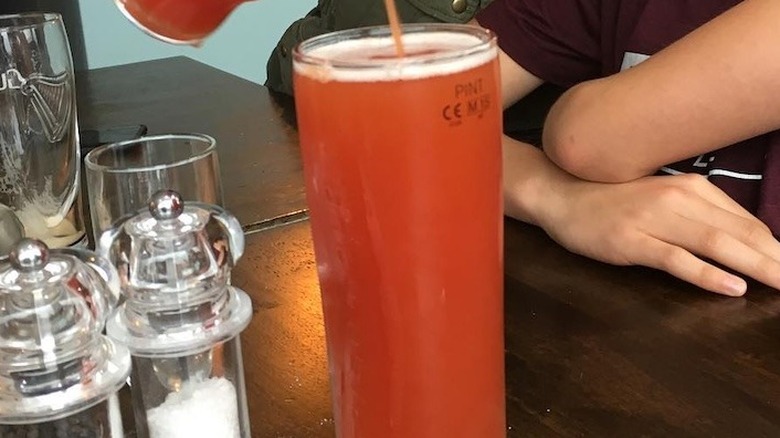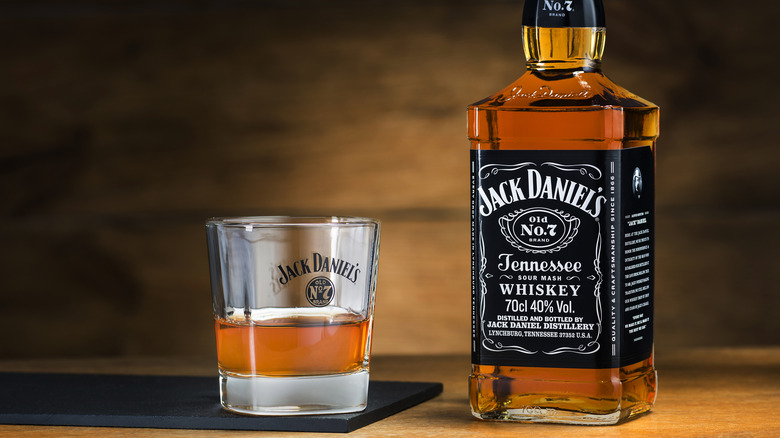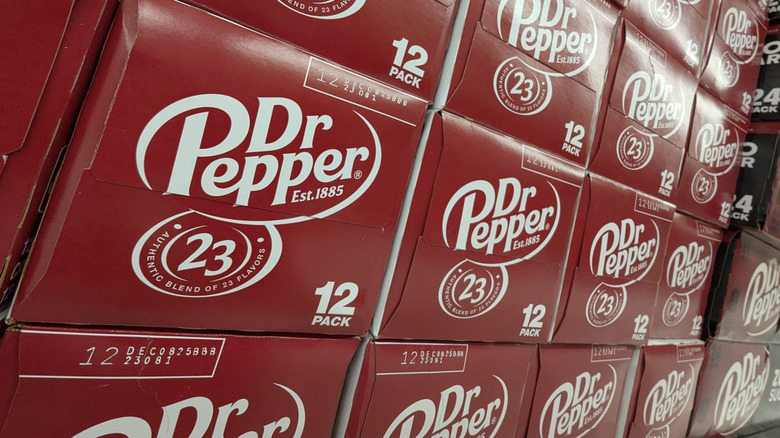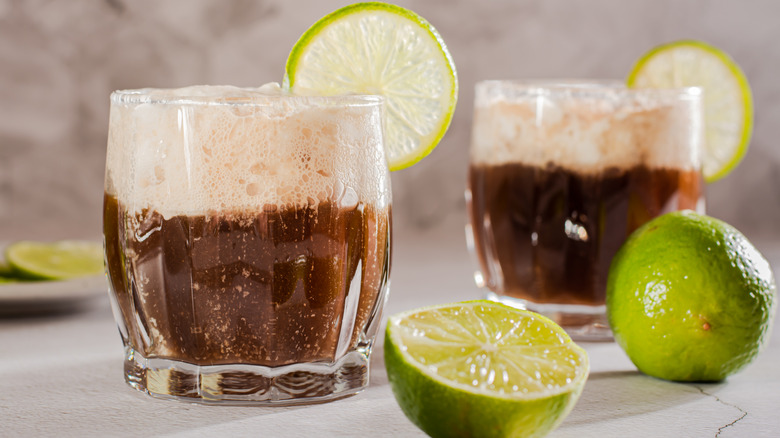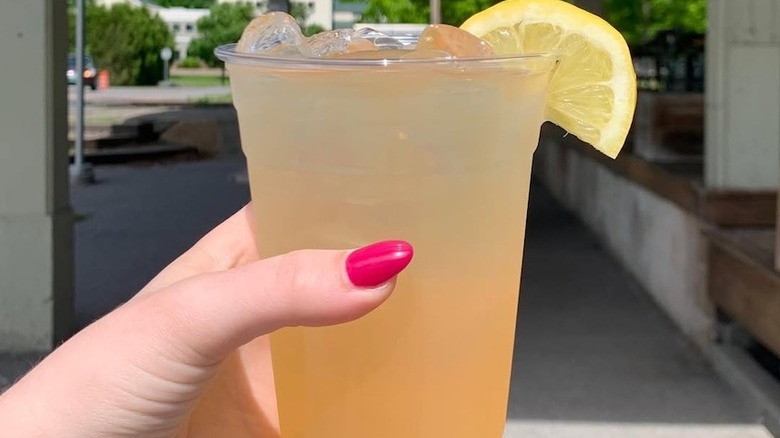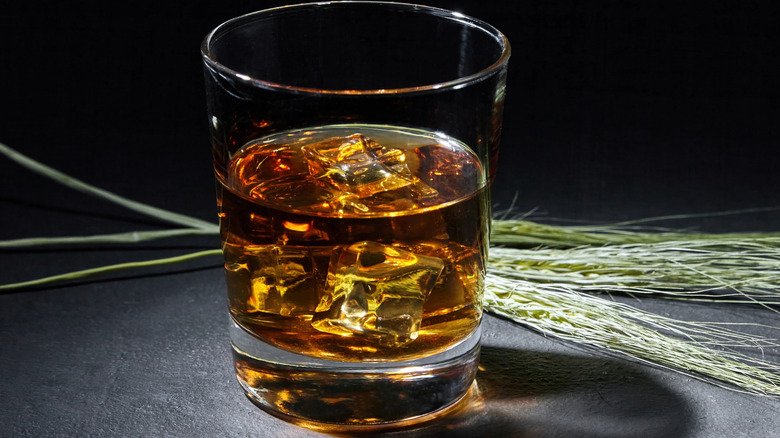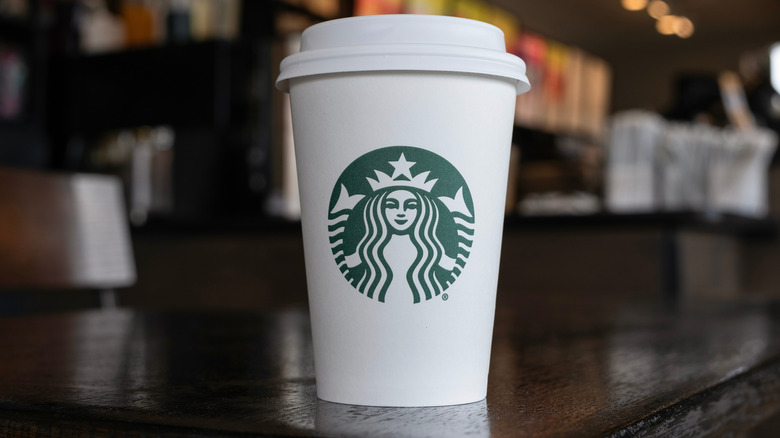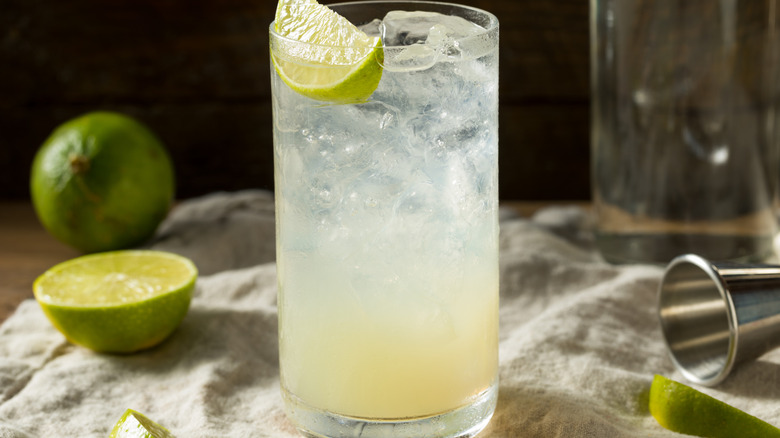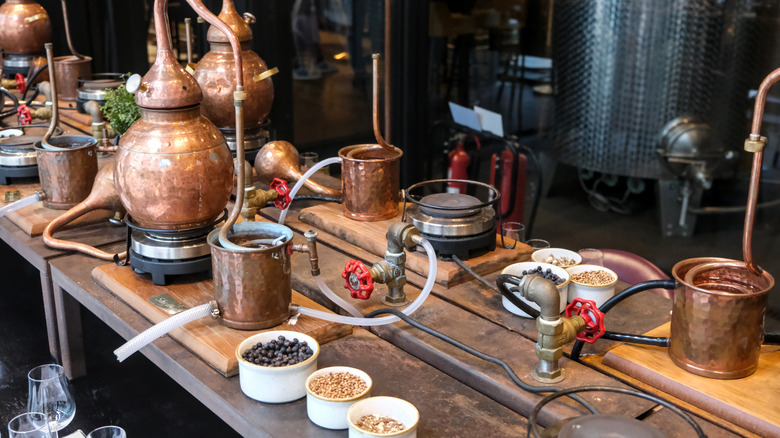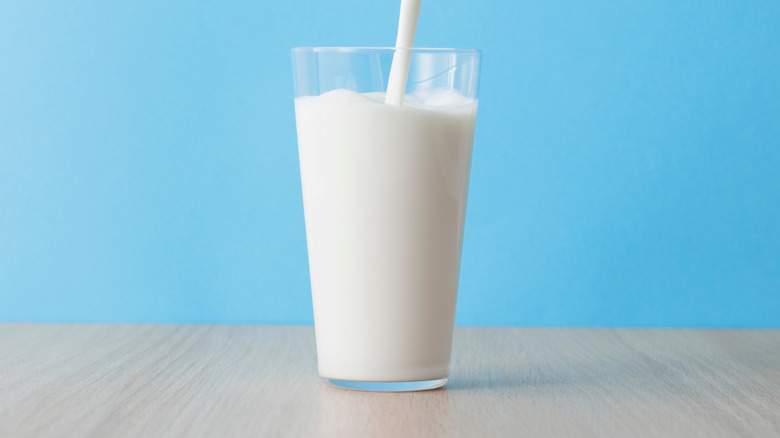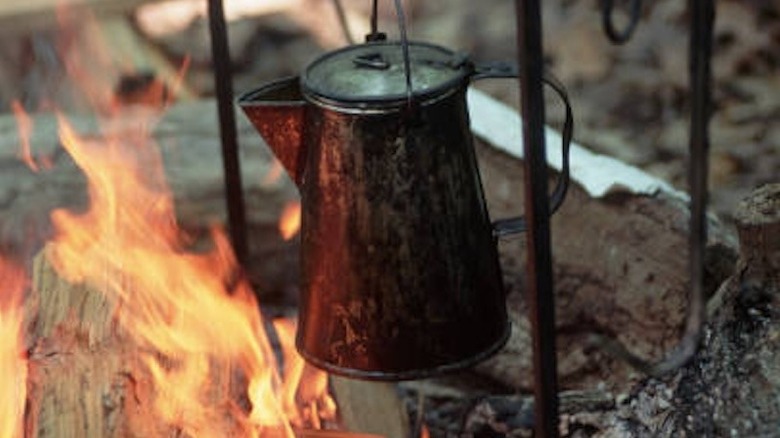Every State's Most Iconic Drink
The United States is a gigantic country, geographically and population-wise. There's very little homogeneity, with a cultural and culinary diversity resulting in part from the fact that there are a whopping 50 separate states in the nation, each with its own traditions, tastes, and commodities. Over at least the last 200 years, a combination of isolation from other communities, self-reliance, and exploiting what grows naturally or could be bountifully cultivated resulted in distinctive foods and beverages endemic to every corner of the country. Another factor: innovation. Farmers, industrialists, cooks, chefs, and bartenders everywhere took what they found around them and created wonderful, delicious, and timeless beverages.
Each of the 50 states has its own drink culture. From alcoholic beverages and soft drinks to juices and sodas, all the states in the U.S. have a beverage they can call their own, whether it was created or originated there. Here's the definitive and most important drink from every state.
Alabama: Grapico
A grape-flavored soda that can be found throughout the South, Grapico is part of the firmament in Alabama, particularly in Birmingham. It's here where beverage distributor Buffalo Rock Company, owner of worldwide rights to Grapico, operates. Drinkers describe the beverage as sweeter and more intensely grape-flavored than many other grape sodas on the market. Bottled in Alabama since 1917, Grapico was popularized by advertising on planes and through a jazz song called "Meet Me in the Land of Grapico."
Alaska: Duck fart
Bars all across Alaska serve their own version of the classic and colorfully named duck fart, a layered shot invented at Anchorage's Peanut Farm in 1987. A patron requested the tri-colored B-52, made of Irish cream with orange and coffee liqueurs. The customer then asked for another, with Crown Royal whisky instead of the orange liqueur, and when she knocked it back, she reportedly made a sound like a duck being stepped on.
Arizona: Lemonade
Arizona has grown a lot of citrus fruits, particularly lemons, for centuries. When teenager Garrett Glover from Gilbert noticed that four of Arizona's most important "C's" were represented on the state seal (cattle, cotton, copper, and climate), but citrus wasn't, he made an effort to change that. In 2019, the Arizona government adopted the widely consumed citrus drink as the state's official beverage.
Arkansas: Grapette
Grapette International set up shop in Camden, Arkansas, in 1939 and quickly became the state's favorite homegrown soda company. While Orangette would earn a fanbase, the powerfully grape-flavored Grapette became a part of the culture in Arkansas. At one point, Grapette was sold in almost every state, but over the years, it dwindled in popularity (while branching out to international markets). Today, it's sold only at Walmart, which also got its start in Arkansas.
California: Napa wine
The Napa Valley area of Northern California is the most prolific and profitable wine-making region in the United States. Commercial production began in the 1860s, but California wines were taken seriously after a Napa Chardonnay and a Cabernet Sauvignon beat French wines in a major 1976 competition.
Colorado: Coors beer
Original Coors Banquet, but especially Coors Light, are among the best-selling crisp lager-style beers in the country. German emigrant Adolph Coors introduced his beer to the state in 1873, and Original Coors Banquet is still brewed at the original location in Golden. The Rocky Mountain water-based brew remained a regional Western specialty until the 1970s.
Connecticut: Foxon Park White Birch Beer
Foxon Park Beverages in East Haven produces a range of soft drink flavors that have been wildly popular in Connecticut since the 1920s and may not be very well known outside of New England. The company's most popular and unique soda is the White Birch Beer. Made from an extract of the Alaskan birch tree, the soft drink tastes a lot like wintergreen.
Delaware: Dogfish Head beers
Dogfish Head Brewings & Eats opened in 1995 in Rehoboth Beach, Delaware, helping to jump-start the small-batch or craft brewing movement. The first brewpub in the state, Dogfish Head made its own beer and has since become one of the famous and influential indie brewers in the nation. Popular beers include the brand's 60, 75, 90, and 120 Minute IPAs, Noble Rot, and Punkin Ale selections.
Florida: Orange juice
In the 16th century, the first orange trees in North America were planted in what is now St. Augustine, Florida. An abundant crop in the peninsula's tropical climate, oranges were first cultivated commercially after the Civil War. By the mid-20th century, Florida was one of the country's top suppliers of both freshly packed and frozen orange juice.
Georgia: Coca-Cola
The most famous and most widely consumed carbonated soft drink on the planet started out as a local Georgia favorite. In 1886, Dr. John Pemberton took what he thought was a sweet, pep-providing syrup utilizing the coca leaf and the kola nut to Jacob's Pharmacy in Atlanta. By the end of the century, it was one of the most popular sodas in the country. Coke still keeps its headquarters in Atlanta.
Hawaii: 'Awa
Hawaii is the state that grows the most coffee, but it also produces a lot of kava. For centuries, indigenous Polynesian cultures, including those historically based in Hawaii, have aggressively treated the roots and the stem of the kava plant to make a drink called 'awa. It's broadly medicinal, enlivening, and relaxing, and is used in religious and political ceremonies as well as to treat minor and moderate ailments.
Idaho: Ironport
In the early 20th century, Ironport (or iron port) was a popular soft drink in the United States. Today, however, you probably won't find it outside the Cache Valley, which covers most of southeastern Idaho. Many restaurants and stores in the area buy syrup in bulk and mix it with soda water. Often boosted with cherry flavoring, iron port reportedly tastes like cola with hints of root beer, berries, and herby sarsaparilla.
Illinois: Green River
During Prohibition, Chicago's Schoenhofen Edelweiss Brewing Company moved into soda, and its signature offering was lime-flavored Green River. Although it's rarely seen outside of Chicago, Green River was so popular in the 1950s that it was the second-best-selling pop in the country. And it's definitely pop — bottles of Green River were once sealed with marbles, which would audibly "pop" out when opened, purportedly coining that synonym for soda.
Indiana: Water
Indiana is the only state whose declared quintessential beverage is vital for survival. Water is the oldest, most natural, and single most biologically important thing that one can drink. Indiana honored it in 2007 when the state senate passed a resolution making H2O the official beverage of the state.
Iowa: Frozen blue water margarita
Iowans are rightfully fond of West Okoboji Lake, which boasts a dynamically bright blue color. That inspired a cocktail served in bars and restaurants all over the state, a take on the classic frozen margarita. It's made with tequila, orange-flavored Cointreau, and lime. The addition of Curaçao, which has a flavor that doesn't match its blue color, gives the drink its resemblance to Iowa's popular lake.
Kansas: Icee
Found in thousands of snack bars and convenience stores across the country, Icee is the top name in super sweet, extra cold, slushy drinks. It traces its origins to Kansas in the 1950s, when Coffeyville Dairy Queen franchisee Omar Knedlik sold semi-frozen Cokes in the summer because he didn't have a working soda fountain. Knedlik later patented a machine in 1960 to make slushies under the Icee name.
Kentucky: Bourbon
Bourbon is a form of whiskey, made from corn and then aged in oak barrels. About 95% of all bourbon comes from Kentucky, where the soil is conducive to corn, and where the cold winters and harsh summers alter the barrels so much that they impart a proper flavor into the liquor. Major Kentucky bourbon producers include Jim Beam, Woodford Reserve, Wild Turkey, and Maker's Mark.
Louisiana: Sazerac
Cajun and Creole cuisine is characterized by a mix of old French and distinctively American components. Sazerac, the definitive cocktail of New Orleans, also blends these influences. In the 19th century, French distillers started sending cognac to New Orleans bars, and bitters pioneer Antoine Peychaud used that spirit to invent the Sazerac. Making a proper Sazerac cocktail involves adding Peychaud's and Angostura bitters to sugar syrup and rye whiskey then pouring it into an absinthe-drained glass.
Maine: Moxie
Created in Union, Maine, in 1884, Moxie was one of the first American-made carbonated beverages. Its popularity has remained confined to Maine and neighboring states, presumably because the drink's original name, Moxie Nerve Food, never gained wide appeal. It's sweet, herbal, and medicinal, and tastes like root beer and licorice, too. The key ingredient of gentian root gives it some bitterness. In 2005, the government of Maine declared Moxie its official state soft drink.
Maryland: Orange Crush
Back in 1995, the Harborside Bar and Grill in Ocean City invented the Orange Crush. It doesn't contain the soda of the same name, but it tastes a bit like it, combining a bit of lemon-lime soda with orange-flavored vodka and the orange-based liqueur triple sec. Orange Crushes still make up a significant portion of Harborside's alcohol sales, and in 2025, Maryland named the drink the state's official state cocktail.
Massachusetts: Cranberry juice
Massachusetts has historically been one of the top three cranberry-producing states, with the majority of the harvest going into making cranberry juice and cranberry juice blends. The Cape Codder cocktail, made from vodka and cranberry juice, even gets its name from a region of the state, whose government named the juice its official beverage in 1970.
Michigan: Vernors
The oldest brand of extant soft drink in the U.S. is Vernors, a ginger ale developed by a Detroit pharmacist in 1862 as a remedy for stomach ailments. It remained a bestseller in Michigan, even after the introduction of numerous other ginger ales and national soda brands, and in 2025 the Michigan legislature voted on naming Vernors the official state beverage.
Minnesota: Swedish egg coffee
When a large number of Scandinavian emigrants settled in Minnesota in the 1800s, they brought with them a traditional coffee preparation. Swedish egg coffee is made by boiling together grounds and a raw egg, including the shell. The alkaline of the egg counteracts the acidity of the coffee, and the resulting cup is a weakly colored by smooth and flavorful brew. It can be found at fairs, potlucks, and church gatherings around the state.
Mississippi: Barq's
Less sweet and with more spice, nuance, and caffeine than can be found in the major name brand root beers, Barq's was acquired and elevated by Coca-Cola in 1995. Sodamaker and chemist Edward Barq developed the sarasparilla-influenced Barq's Root Beer at the Biloxi Artesian Bottling Works in 1898, which was being sold across the country within a decade.
Missouri: Budweiser
Budweiser is the self-proclaimed "King of Beers," because it's been historically been one of the most widely distributed and best-selling beers in the United States. A crisp, lightly alcoholic, American-style lager, Budweiser was first brewed by Adolphis Busch in 1876 and helped establish St. Louis as one of the country's beer capitals.
Montana: Moose Drool Brown Ale
Missoula's Big Sky Brewing Company is among the northwestern U.S.'s most notable craft breweries. Its signature beer is a malty American brown ale named after the packaging art prepared just before the first retail release of the stuff in 1995. There are a lot of moose in Minnesota, and the image of the animal drooling inspired Moose Drool Ale.
Nebraska: Kool-Aid
The artificially fruit-flavored and powdered drink mix found in cupboards across America was developed in Hastings, Nebraska. In the late 1920s, Edwin Perkins took a glass bottled drink concentrate he'd invented called Fruit Smack, dehydrated it, and sold the powder in cheaper, safer packets. Sugar-added Kool-Aid packets were perfected in the 1970s, and the beverage was later named Nebraska's official soft drink.
Nevada: Picon punch
Traditionally consumed as a rite of passage for newly arrived residents of Nevada, Picon punch was popularized by the state's Basque diaspora in and around Reno. It's as sweet as it is strong, a blend of grenadine, soda water, poor quality brandy, and plenty of Amer, a boozy and sticky liqueur that tastes of citrus fruit.
New Hampshire: Apple cider
The only kind of apple that's indigenous to New Hampshire is the crab apple, bad for eating but perfect for cider, both alcoholic and nonalcoholic. New Hampshire is a tiny place, and 150 apple farms use 1,400 acres to grow the raw materials for cider, which in 2010 was named the official beverage of the state.
New Jersey: Boylan sodas
Production on the line of sodas made by Boylan Bottling happens in New York City, but New Jersey was the birthplace of the company in 1891 and still its major market. Williams Boylan started selling his mixtures at his pharmacy, striking on a unique blend that took off with locals called Boylan's Birch Beer. Caffeine free and made with real sugar, it's flavored with sweet birch and wintergreen oil.
New Mexico: Agua fresca
There's evidence that the category of freshly prepared, cool and refreshing drinks known as aguas frescas, Spanish for "fresh water," were developed when the Aztec empire ruled over Central America. The process of grinding fruits, seeds, flowers, and grains with water and sugar persisted into what's now Guatemela and Mexico, and then into the state of New Mexico. By the 1940s, aguas frescas stands and street vendors were common in New Mexican cities, with the most favored styles made with pineapple, tamarind, watermelon, and cantaloupe.
New York: Egg cream
Before the days of mass-produced bottled soft drinks, beverages were procured at soda fountains in drugstores. A holdover from that early 20th century era is a New York City original called the egg cream. There's no egg or cream to be found in the egg cream drink, which is a smooth, bubbly, and sweet beverage with a big head on it that comes from mixing very cold milk with seltzer water and chocolate syrup.
North Carolina: Cheerwine
The reason that Cheerwine was invented in Salisbury, North Carolina, in 1917 was to get around strict sugar rationing laws in place. L.D. Peeler took an intensely cherry flavored syrup made with almond oil, which when mixed with carbonated water, it became Cheerwine. Marketed as the "Nectar of North Carolina," Cheerwine is sold at stores and restaurants throughout the state, and it's often used as a cherry-imparting ingredient in baked goods.
North Dakota: Chokecherry wine
Found throughout North America but especially prominent in the Midwest, the chokecherry is a relative of the rose, with its bark used to make natural medicines and the edible fruit used to make jam, juice, and paste. In North Dakota, chokecherry berries are treated like grapes and orchards there use it to make wine that's rather dry but decently bodied and packs a wallop of a distinctively fruity taste.
Ohio: Tomato juice
The Ohio General Assembly proclaimed tomato juice the official state beverage in 1965, because at the time Ohio harvested more tomatoes than anyone else by California. Reynoldsburg native Alexander Livington developed the first commercial tomato, along with about 40 other varieties, making Ohio the American ancestral home of the fruit and its products, like juice.
Oklahoma: Cherry limeade
Fast food chain Sonic Drive-In got started (and is still based in) Oklahoma, where it serves so many different drinks that it claims there are more than a million possible options. Easily one of its most popular is its signature cherry limeade line, with millions of gallons of the syrup-addled lemon-lime soda with pebble ice consumed each year.
Oregon: Craft beer
Countering the lightly flavored lagers produced by nationally distributed breweries are craft beers: dense, flavorful, hops-forward beers of all kinds, although usually IPAs with a relatively high alcohol content. There are around 400 small breweries and independent brewpubs in Oregon, all making their own beer in an artisan style pioneered in-state in the 1980s by Widmer, Full Sail, and Rogue Ales.
Pennsylvania: Yuengling Traditional Lager
German emigrant David Yuengling moved to Pottsville and set up his eponymous brewery in 1829, which makes it the oldest beer maker in the United States. An early recipe for a lager was reintroduced in 1987, and the Yuengling Traditional Lager quickly became an institution around Pennsylvania, particularly in Philadelphia. It's so well-known that if one plainly orders a "lager," in a bar in Philadelphia, they're likely to get a Yuengling.
Rhode Island: Coffee milk
In 1993, coffee milk was named Rhode Island's official beverage. The key ingredient in the state's staple: Autocrat syrup. Sweetened and concentrated and similar to chocolate syrup, it gives milk a sugary and coffee-like taste. Other syrup brands like Coffee Time and Eclipse persist as Rhode Island favorites, while pre-made coffee milk is also made by local dairies.
South Carolina: Sweet tea
Tea was grown in the U.S. for the first time at a plantation near Summerville, South Carolina, in 1799. Iced tea became popular thanks to the 1904 World's Fair, inspiring Summerville tea growers to serve their product cold. They added ice and large amounts of sugar to strongly brewed tea, creating a beverage popular throughout the hot and humid South — but it's Summerville that is known as "The Birthplace of Sweet Tea."
South Dakota: Red beer
Not to be confused with Irish red ale, red beer is one of the most common bar orders in South Dakota, in its cities, college towns, and ranch areas. While it's unclear how or when the practice started, bars in South Dakota go through a lot of bottles of tomato juice, which is what makes any beer into red beer — it's just the alcoholic brew cut with the acidic fruit product.
Tennessee: Jack Daniel's
Probably the most famous whiskey in the country, or even the world, is Tennessee-style sour mash whiskey, made by the Jack Daniel Distillery in Lynchburg. Also known as Old No. 7, Jack Daniel's gets its particular taste and smoothness because of the technique developed in the mid-19th century: it's treated with charcoal.
Texas: Dr Pepper
In 1885, Morrison's Old Corner Drug Store pharmacist and soda fountain operator Charles Alderton struck on a recipe for a soft drink made with 23 flavors. How the Waco-made beverage got its name is lost to history, but Dr Pepper has been bottled in Texas for decades. By the 1980s, the mysteriously flavored Dr Pepper brown soda was one of the top selling soft drinks in the country.
Utah: Dirty soda
Historically, the state has been predominantly occupied by members of the LDS church, also known as Mormons. That religion bans alcohol and hot drinks like coffee, so in Utah, dirty sodas took root where the flavored coffee drinks popular elsewhere could not. The state is full of bars that serve non-caffeinated sodas that are made "dirty" with the addition of cream, fruit, and or extremely sweet flavor syrups.
Vermont: Maple lemonade
The forests of Vermont produce more maple syrup and maple-flavored products than any other state. In Vermont, maple shows up almost everywhere, used as a sweetener where other kinds of sugar might be employed. That includes a cooling drink rarely found outside of the state: maple lemonade. It's simply freshly squeezed lemon juice, water, maybe some herbs, and enough maple syrup to sweeten the batch and lend a bit of earthy maple flavor.
Virginia: George Washington's rye whiskey
Made with at least 51% rye as its source grain, rye-style whiskey has more heat and less sweetness than its counterparts. Rye cultivation, and turning it into alcohol, took off in colonial America, and President George Washington grew the grain at his sprawling property in Mount Vernon, Virginia. In the present day, Mont Vernon Distilleries produces a rye whiskey based on Washington's recipe, which is also Virginia's state spirit.
Washington: Starbucks
Before Starbucks became the second biggest restaurant chain on Earth, it was but one small shop in Seattle, Washington's bustling Pike Place Market. It sold premium, whole bean coffee before expanding into European-inspired cafés offering a full line of highly caffeinated espresso-based drinks like lattes and mochas, which played well in rainy Seattle and the rest of the Pacific Northwest.
Washington, D.C.: The Rickey
The nation's capital city has its own officially designated cocktail: the Rickey. Served in a tall highball glass, it's a summery combo of freshly squeezed lime juice, club soda, and a shot of either bourbon or gin. It was created on a whim in 1883 by the bartender on duty at Shoomaker's Bar, nearby the White House, at the behest of thirsty lobbyist Joe Rickey.
West Virginia: Moonshine
As far back as the late 18th century, homemade whiskey was being made in the rural mountains of West Virginia. With that cover from alcohol regulators and tax agents, locals made and sold their own monumentally potent hooch — also known as white lightning and moonshine — from stills out of fermented corn, which grew well in West Virginia.
Wisconsin: Milk
Wisconsin's license plates declare the state "America's Dairyland," a fitting slogan for a place that's home to more than 1.2 million cows that make billions of dollars' worth of milk and cheese each year. The dairy industry is big business in Wisconsin, and it has been for so long, that in 1987, the state government named milk its official beverage.
Wyoming: Cowboy coffee
Evoking the cowboys of yore who drove cattle across the expansive Wyoming wilderness, cowboy coffee is made in cafés and at home in much the same way it was done more than a century ago over campfires. A heaping spoonful of coffee grounds is stirred into boiling water in a tin pot, then taken off the heat to allow for brewing and settling, the latter aided with a splash of cold water.
